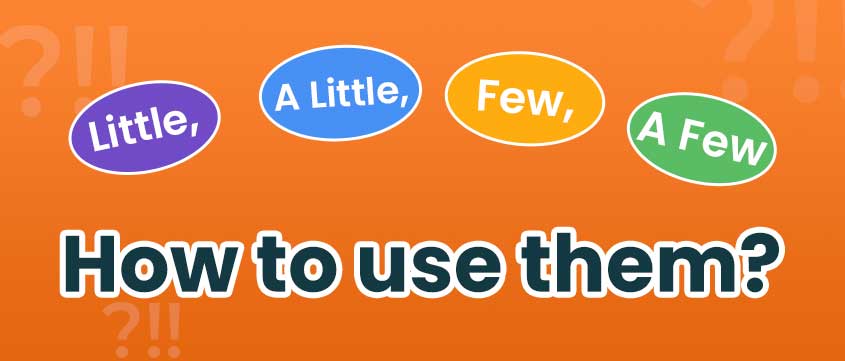Do you ever find yourself confused about when to use “little”, “a little”, “a few” and “few”? All of these words are quantifiers (words that denote the quantity of something), but their usage greatly depends on the context of the sentence. Read along to get a clear idea about how and where to use these words in your writing and conversations.
Let us first look at “little” and “a little”,
Both of these quantifiers are used with uncountable nouns to refer to a small amount of something. But, does it make a difference to the meaning of the sentence if we add the article ‘a’ before ‘little’? Yes, it does.
Both of these quantifiers are used with uncountable nouns to refer to a small amount of something. But, does it make a difference to the meaning of the sentence if we add the article ‘a’ before ‘little’? Yes, it does.
The major difference is, we use “little” in negative sentences and “a little” in positive sentences.
For example,
1. I’m sorry, I speak little Spanish (negative sentence)
2. I am glad I can speak a little Spanish. (positive sentence)
2. I am glad I can speak a little Spanish. (positive sentence)
In the first sentence, the person implies that, even though he/she speaks Spanish, their knowledge is very limited and will not be useful in that particular context. But, the second sentence implies that the person can speak a little bit of Spanish which is consequently beneficial for the context mentioned in the sentence.
"Free English courses (with certificates), Podcasts, Quizzes, and many more learning modules on the Red Fox Education mobile app."
Here goes another example,
1. We had little time to prepare for the exam. (There was no time to prepare for the exam.)
2. We had a little time to prepare for the exam. (They had some time to prepare for the exam.)
2. We had a little time to prepare for the exam. (They had some time to prepare for the exam.)
So, when we use “a little” in a sentence, it means ‘a small amount’ or ‘some’. On the other hand, when we use “little”, it implies ‘almost nothing’ or ‘not so much’.
Similarly, the quantifiers “a few” and “few” are also used to refer to a small amount of something. Unlike, “a little” and “little”, they are used with countable nouns. The following example will help you understand this better.
1. There are few apples left in the basket. We should buy more tomorrow.
2. There are a few apples left in the basket. That will be enough for tomorrow.
2. There are a few apples left in the basket. That will be enough for tomorrow.
The first sentence has a negative meaning implying that the apples are not enough. But, in the next sentence, the article “a” before the word “few” made all the difference. It changed the meaning from ‘having almost no apples’ to ‘having enough apples’.
The words “little”, “a little”, “few”, and “a few” can be tricky for English learners. However, understanding their difference is significant to communicate effectively in English. With practice and patience, you can master their usage and can confidently use them in your conversations.
Subscribe to our "Premium plan" and get unlimited access to our Premium products. Red Fox Education's English courses will give you the language and the confidence you need to hold conversations in spoken English relevant to each of the topics.
Mar 09, 2023 | English,Grammar | No Comments











